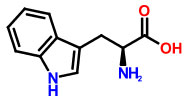Although more than 250 amino acids have been found in nature but only twenty of these are required for human growth.
These twenty amino acids are classified into two groups: nonessential and essential.
Essential amino acids must be obtained from the diet. These include threonine, leucine, lysine, methionine, valine, isoleucine, tryptophan, and phenylalanine.
One of the amino acids – histidine is called semi-essential because it is necessary for proper growth in children.
Nonessential amino acids are those that the body can manufacture from the essential amino acids or normal breakdown of proteins. The non-essential amino acids are alanine, arginine, serine, aspartic acid, cysteine, glutamine, asparagine, glycine, glutamic acid, proline and tyrosine.
Amino acids, as the building blocks of the most diverse biological compounds, have a characteristic structure. All twenty amino acids have an amino group and a carboxyl group with a functional group covalently bound to the alpha carbon. In the essential amino acids, the functional groups are used to classify the amino acids into polar, non-polar, or basic side chains.
Here is a closer look at the eight essential amino acids and the important roles they play.
Threonine T (Thr)

Threonine supports the immune system by aiding in the production of antibodies, and since it is found largely in the central nervous system, may be helpful in treating some types of depression. Threonine is an important part of numerous proteins in the body and is required in forming tooth enamel, collagen and elastin, which are responsible for healthy skin and wound healing.
Leucine L (Leu)

Leucine is a very important amino acid and nutritional component because it controls your body’s ability to process protein, vitamins and minerals. If you do not have enough this amino acid in your system, your body will not be able to properly absorb the protein and vitamins that you consume.
Lysine K (Lys)

Lysine helps make carnitine, which converts fatty acids to energy, and it helps form collagen needed for connective tissue and bones.
Methionine M (Met)

Methionine is an intermediate in the biosynthesis of cysteine, carnitine, phosphatidylcholine and other phospholipids. Improper conversion of methionine can lead to atherosclerosis.
Valine V (Val)

Valine is involved in glucose metabolism and also regulates the immune system. Athletes sometimes use L-valine for muscle metabolism and to help speed up recovery time after seriously rigorous exercise.
Isoleucine I (Ile)

This amino acid is needed for the formation of hemoglobin, which carries iron in the blood, and for the regulation of blood sugar, which is burned for energy in the muscles during exercise.
Tryptophan W (Trp)

L-Tryptophan is an essential precursor to a number of neurotransmitters in the brain. This amino acid plays a role in balancing mood and sleep patterns, helps support relaxation and feeling better.
Phenylalanine F (Phe)

Phenylalanine plays a key role in the biosynthesis of other amino acids and is important in the structure and function of many proteins and enzymes. This amino acid is converted to tyrosine, used in the biosynthesis of dopamine and norepinephrine neurotransmitters.
The eight essential amino acids are responsible for a vast array of metabolic, physiologic, and therapeutic effects throughout the body. In addition to their roles in peptide and protein structure, these free amino acids have significant functions as specialized nitrogen containing products, neurotransmitters, and as alternate energy sources.
The amino acids play an important and unique role in the body and therefore they must be obtained from the diet.
The information was taken from the www.aminoacidsguide.com website.
Tags – aminos, amino acids, aminoacid, amino asit
StumbleUpon | Digg | Del.icio.us | Newsvine | Spurl | Reddit




